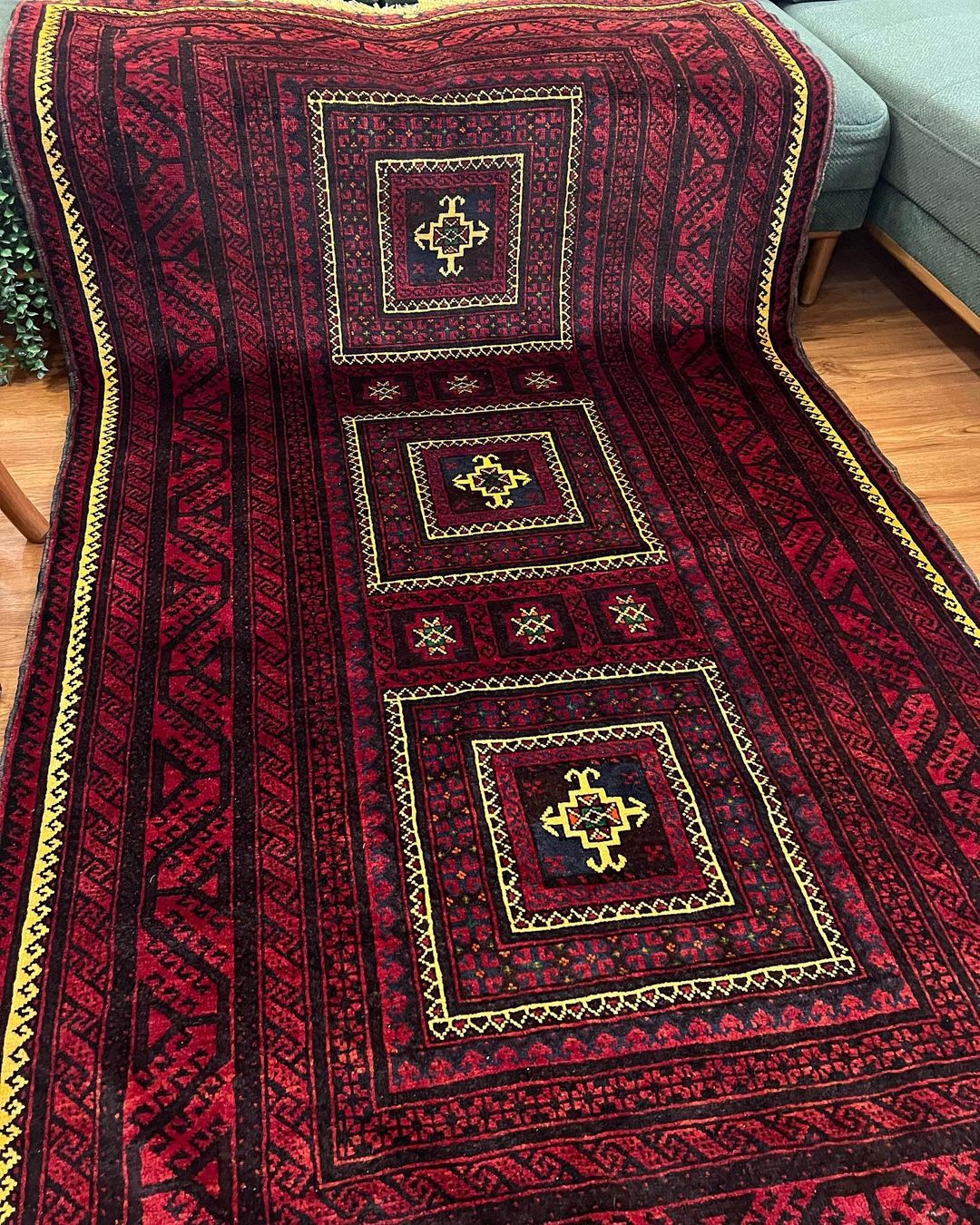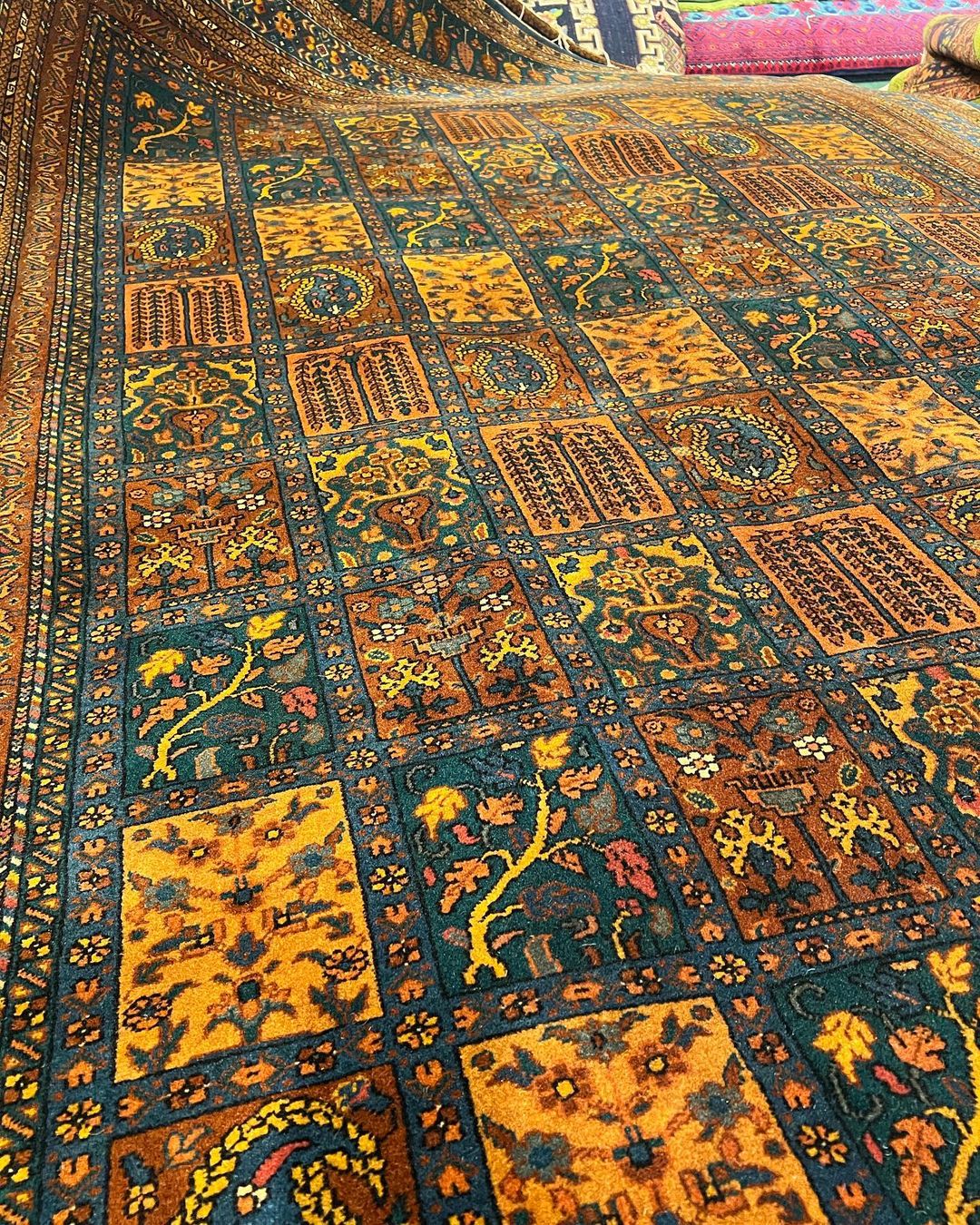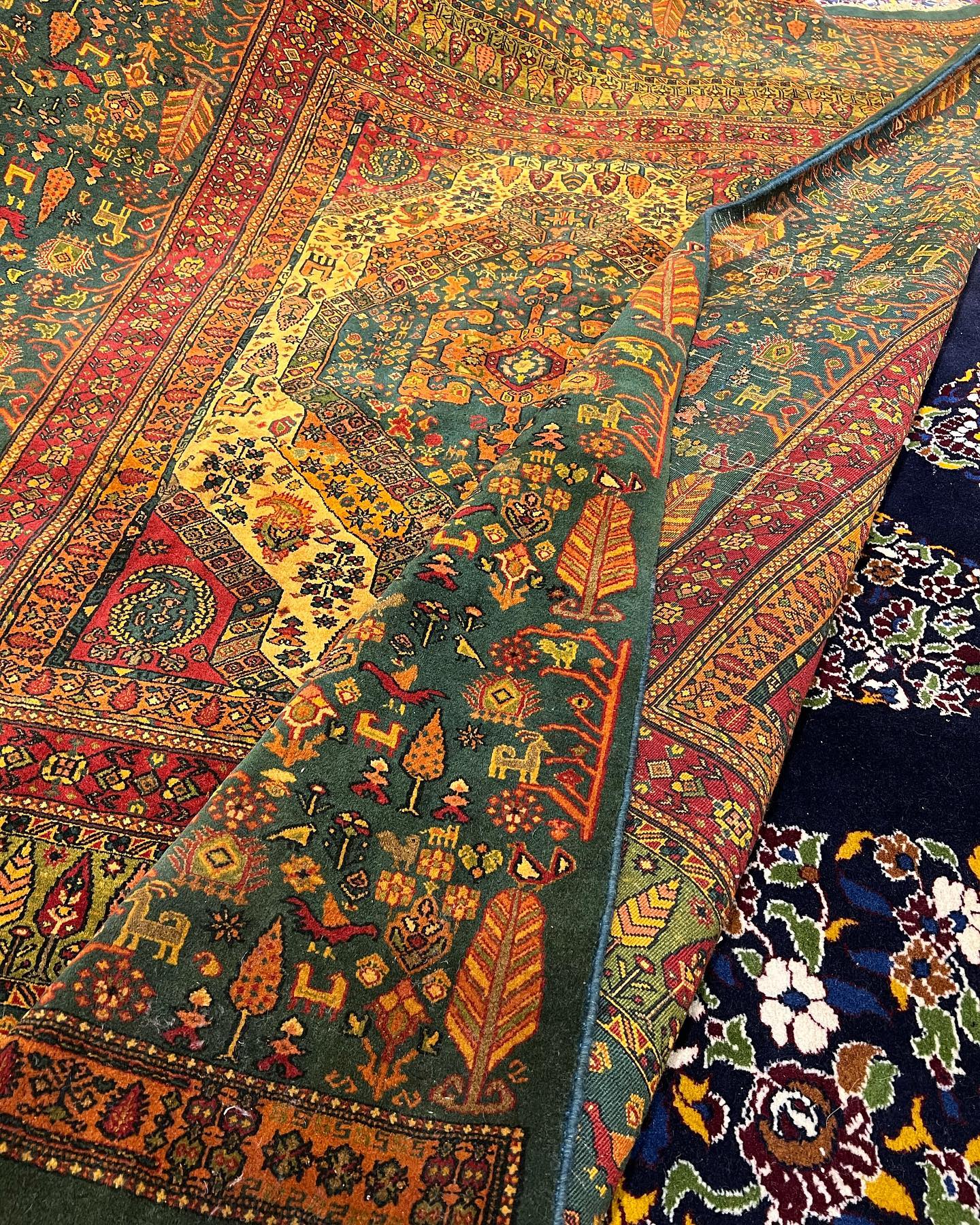The History of Shahsavan nomads
The History of Shahsavan nomads .During the second half of the fifteenth Century.(Persian carpet) dynasties of Turkish origin who carried names with totemic roots, established autonomous sovereignty in parts of Azerbaijan.
They contested the sovereignty of the lands from the Caucasus to the north-west of Iran and to Iraq. The first to assert themselves were the Qara- Kuyunlu, or Black Rums: a Shiite dynasty which grew out of the Baharlu clan.
They claimed their autonomy from the Mongol Jalairid kingdom witha victorious military campaign. In 1382, their khan, Qara Mehemet, established his capital at Tabriz.
In 1465, the Qara-Kuyunlu had to renounce their Azerbaijan kingdom to the Ak-Kuyunlu, or White Rums. They were Sunni Muslims from the Bayandir; one of the oldest Turkish clans,
Iinked in tribal epic to the legendary Oghuz Khan, father of all the Turkish tribes. The History of Shahsavan nomads
(Click on the opposite link to see precious Iranian handmade and machine combined silk carpets)
The new king, Uzun Hasan, made Tabriz his capital and his dynasty remained in power until I502, when the kingdom was annexed by the Safavids. Azerbaijan hosted an important religious centre.
The city of Ardebil from the thirteenth Century onwards, was home to one of the most important Sufi sanctuary in Iran, which even the Mongol invaders respected.
It was founded around 1250 by Sheikh Safieddin, who was invested of a certain authority as he was a descendent of the imam Ali, the son-in-law of the Prophet Mohammad and venerated by Shiite Muslims. As a charismatic figure, he managed to call 13,000 faithful from Anatolia and Iraq to Ardebil.
The sanctuary was free from outside political influences and the descendants of Sheikh Safieddin enjoyed undisputed authority. Timur also respected the holy authority of the Safieddin heirs, at that time a certain Khwajeh Ai, and ordered that none of his property be touched. persian Handmade carpet
In exchange for Khwajeh Ali’s intercession, according to contemporary historians, Timur ordered the liberation of 30,000 Turkish prisoners, many of whom remained in the Ardebil area.
The origins of the Rumlu clan are attributed to these ex-prisoners. Certain Turkish clans, such as the Shamlu, Qajar, Takkalu, Afshar and Rumlu were linked to the Sufi movement. They enjoyed significant political independence. In the course of the fourteenth and fifteenth centuries, they joined together to form a confederation which took on the rather emblematic name of
Kizil Bush, or the Red Turbans.

In contrast to the majority of Turkish tribes, the Kizil Bush were Shiite, rather than Sunni Muslims. In the beginning, the confederation had strong mystical connotations: the chiefs had political and military power, but above all, they held religious authority and were linked to the Sufi movement ofArdebil.( Persian carpet designs)
The red turban with its twelve folds, which gave them their name, was a declaration of their devotion to Ali, the first Shiite saint and son-in-law of the Prophet. His symbol was a lion with a
raised sword, called the Taj-e-Heydar: the throne of Heydar It quickly became the symbol of the confederation.
From the middle of the fifteenth Century, Sufi authority predominated in the confederation. This was mainly due to the work of one man, Sheik Junaid (1447-1470). He organised the Kizil Bush into an army and turned the school in Ardebil into a military barracks, complete with workshops where weapons and armour were produced.
The importance of the Sufi sheikh was such that the future sovereign, Uzun Hasan, gave him his own sister as his bride. Junaid was succeeded by his son, Sheikh Heydar (1470-1488), who took the daughter of Uzun Hazan as his wife. He was killed in battie in 1488, having established the authority of the Kizil Bush.
In the first years of the sixteenth Century, the Kizil Bush sustained their rapid climb to power through the young son of Heydar, Ismail. He was the spiritual leader of the confederation and in I501, at the age of fthirteen, was already destined to become the founding father of the mnost important ruling dynasty of Persia: the Safavids. (Historical changes styles of Persian carpet)
According to contemporary sources, the Kizil Bush confederation consisted of thirty-two different tribes.
This is documented in wo different manuscripts; that of Pietro della Valle. the Italian ambassador who arrived in Safavid Persia between 1625 and 1630, and in an carlier work by Owrug Beg. Both number, with some variations, thirty-two diflerent tribes whose names confirm their Turkısh origins and underline the importance of some tribal names, still to be found among Persian nomads today.

According to existing knowledge of the Turkish tribes’ social structure, the divisions between the clans showed considerable movement and energy: repeated alliances and divisions, usually the result of war or shifting territories, Among the tribes mentioned are the Shamlu, who originally came from Syria (Sham, in ancient Arabic), in the areas around Aleppo, Tarsus, Adana and Damascus.( Silk carpet)
They reached Azerbaijan at the end of the fifteenth Century through Timur’s volition, and the Baharlu, an old clan of the Kara Kuyunlu who take their name from a district near Hamadan.
The presence of the Ustajlu, or rather “the disciples’ has been documented in Turkish Kars since the fiftecenth Century. During the Safavid period, the governor of Diyarbekir was chosen from the tribal aristocracy.
As a result, they settled close to Lake Van as did the Zolk’adr, which include the Karamanlu, (who originated from Aleppo and later settled around Gendje), and the Varzak, who originally came from Karaman and Cilicia. The History of Shahsavan nomads
The Takkalu also originated in southern Anatolia. It is thought that they settled in the Teke area and are connected, as their name suggests, with the Turkoman Tekke clan The Qadjar, (who at a later date, were to found the Persian dynasty of the samene) are linked to the Mongol clan Jalaier, who govemed Baghdad at the beginning of the fourteenth Century.
It is believed that the Qadjar reached Azerbaijan with Timur and quickly integrated with the Turkish peoples. However, some sources say that they were in fact, of Turkish origin and were captured by Timur who deported them to Azerbaijan.

The Rumlu tribe shareda similar fate. They had lived in Anatolia, near Sivas since ancient imes, and were moved to Ardebil by Timu. – The Bayat left the Syrian plains for the valleys of Hamadan in the sixteenth Century. Persian Rural carpet
Their name is reminiscent ofa Turkish khan and grandson of Oghuz Khan. The Khalaj, of ancient
Turkoman origin, are recorded as being settled around Saveh since the beginning of the fifteenth Century.
Records also mention the Afshar, who belong to one of the oldest and most important of the Turkish clans. Tribal tradition recounts that they too are descendants of a grandson of Oghuz
Khan, The Afshar were among the first of the Turkish clans to reach the Iranian plateau. Among other places, they initially settled along the Persian Gulf coast.
The assertion of Safavid authority coincided with the affimation of the Kizil Bush confederation. Their power and continual interference in Safavid dynastic succession were Such that they appeared to be in revolt. Shah Abbas (1589- 1629) was forced to take drastic counter-measures and called the people around him thanks to a ban, said ‘Shah savani The ban ‘Shah savani’ had been commonly used by previous rulers.
It was a rallying-cry to a Shah’s staunchest supporters (the name Shahsavan has the same meaning), and was used to create a kind of special guard which was then used to put down any rebellion. The ban had political and military clout, but it also had religious importance: once the religious authorities were part of the new Safavid power base.
Shah Abbas’s father had made the ban to appease a revolt in I581. The History of Shahsavan nomads
The cry Shah savani was a most effective instrument in struggles for succession. Contesting heirs were each supported by different clans. Shah Abbas’s own succession to the throne was established as the result of an argument between the Shamlu, Ustajlu and other clans of the Kizil Bush.

Even on the first day, more than a thousand volunteers had replied to Shah Abbas’s ban. The Shahsavan army became an invincible weapon which the Shah turned on the troops of the Kizil Bush, the Ottoman Turks, who were pressuring the western borders, and the Uzbeks, who threatened in the north-east. Style and maktab of Persian carpet
Thanks to the faithful services of the Turkish tribes, Abbas was able to defeat the Georgians, Circassians, Armenians and Tagiks. In exchange he exalted the tribes’ position and encouraged a policy of ethnic integration, which aimed to create new stability in Iran.
To heighten their strength and increase their numbers, the Shah allowed Turkish families who were linked to those who had served him so faithfully, to move to the plains and valleys of Azerbaijan These families, who had been living in Anatolia, had begun to suffer from the Ottoman Empire’s efforts to contain their independence.
Under Yunsur Pasha, more than 30,000 families arived in Persia. Many of them were Afshar
(who played a key role), but there were also Takkalu, Zulk ‘adr. The History of Shahsavan nomads
Shamlu (Ajirlu. Inanlu and Begdilu) peoples From this nucleus, the Shahsavan confederation was born.
It is not certain that it was formally instituted and recognised by Shah Abbas Certainly a number of sources were referred to the confederation from the beginning of the eighteenth Century onwards. They settled mostly on the Moghan Plain, but also around Hamedan and Saveh. The History of Shahsavan nomads
The Shahsavan were numerous, respected and fora timne werea special corps in the Satavid army. With the breakup of the dynasty and the fall of Isfahan in i722, the Shahsavan were forced to contend with the expansionist ambitions of Peter the Great of Russia, who had long been interested in the plains and approaches of Persian Azerbaijan.
Taking advantage of the weak borders, the Tsar conquered a large area of the Caucasus which was recaptured ten years later by Nadir Shah, the new ruler of Persia (1736-1747), OfAfshar
origins, he re-invested the Shahsavan khans with political and military roles, entrusting them with the control of the northern borders.
Above all else, Nadir Shah must be remembered for his reorganisation of the nomads fragmented territories. It was by his decision that the Inanlu abandoned their lands in Azarbaijan, resettling around Saveh.
Around the middle of the Century, the confederation split intó two branches following a dispute between Bader Khan’s sons. One group, led by Nazir Ali Khan, continued its links with the city of Ardebil, while the second, faithful to Koutchak Ali Khan, chose to settle around Meshkin. Although weakened by the internal rift, the confederation continued to play an important role until the nineteenth Century.
The renewed outbreak of hostilities between Russia and Persia, caused the Shahsavan to lose their best territories. With the Treaty of Golistan in 1813, Daghestan, the Asferon Peninsula and the fertile Talish were ceded to Russia. Fifteen years later, the newly- victorious Russia permanently acýuired the Moghan Plains and the province of Erivan under the Treaty of Turkomanchai.
The border along the river Araks was also established. Despite the new political situation and the opposition of the Ruşsian border guards, the nomads continued for several decades to migrate to their traditional pastures in the Moghan each winter, for several 25 The snow-covered peak of Mount Sabalan, decades. The History of Shahsavan nomads
From the midnineteenth Century onwards, the Russians stepped up their campaign of harassment in the area, taking advantage of a total absence of central power in Persia. In 1 884, the borders were permanently closed and spates of persecution followed: villages were razed to the ground and entire families wiped out.

The Shahsavan began to arm themselves in order to defend their traditional rights. Some family groups moved to the Anatolian valleys while others continued to face the russian troops.
In one particular yea, the Russians halted the nomads during their seasonal migration and confiscated their animals, tents and effects. According to the Persian government of the day, these were destroyed or redistributed. The History of Shahsavan nomads
The confederation never fully recovered from this severe blow, which marked the end of their political importance in Azerbaijan. From 1924 onwards, Reza Shah, fouhder of the Pahlevi dynasty, embarked on a struggle against the nomadic peoples’ autonomy.
Migration was forbidden, even to the Shahsavan, as were speaking their native languages and wearing traditional dress. As elsewhere, Azerbaijan saw revolts, epidemics and famines which
decimated the population.
With the abdication of Reza Shah in1941, only a few groups of Shahsavan returned to the age-old nomadic life. They migrated within the Persian borders, from their winter quarters among the villages in Persian Azerbaijan, to the summer pastures in the mountain valleys.
